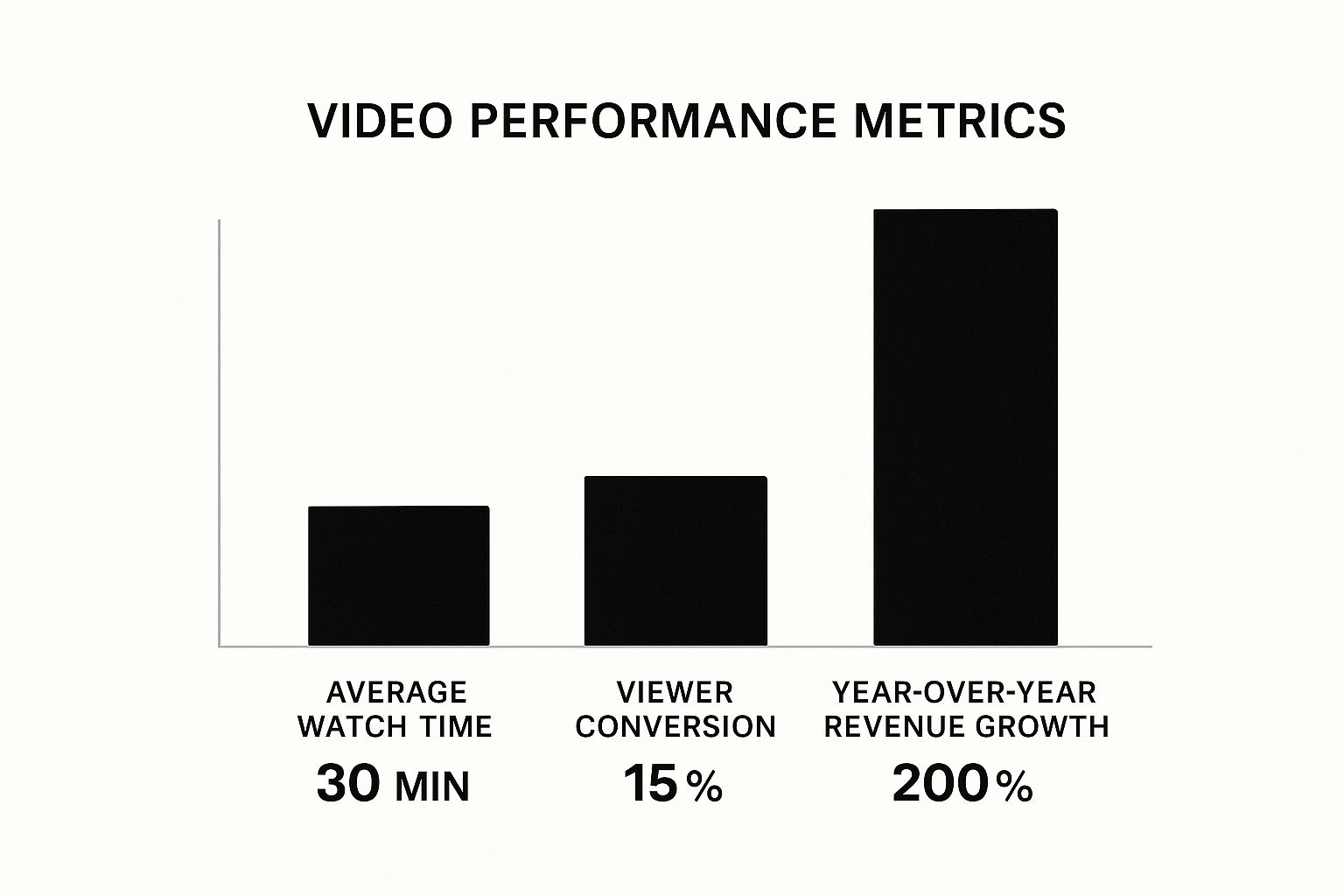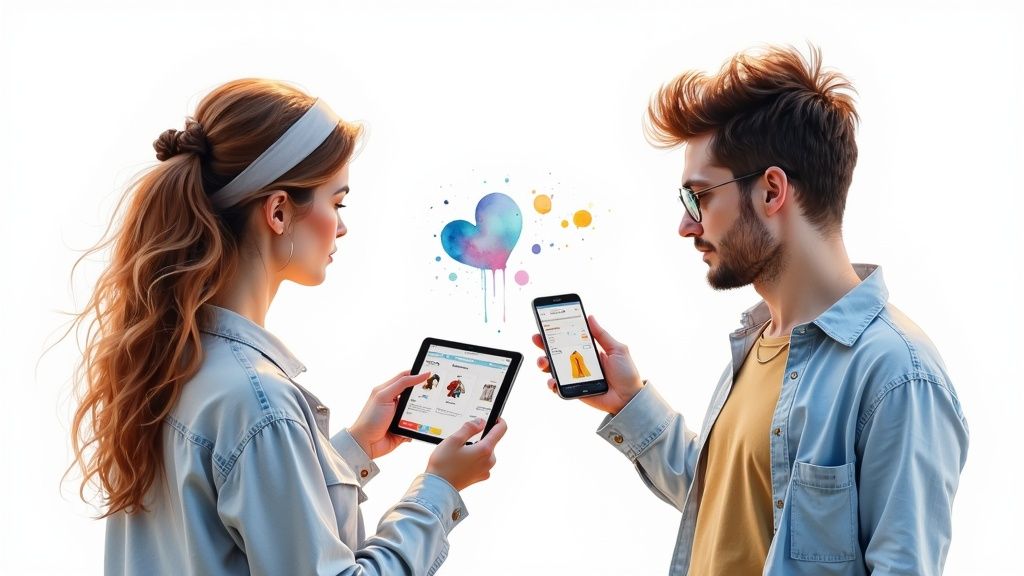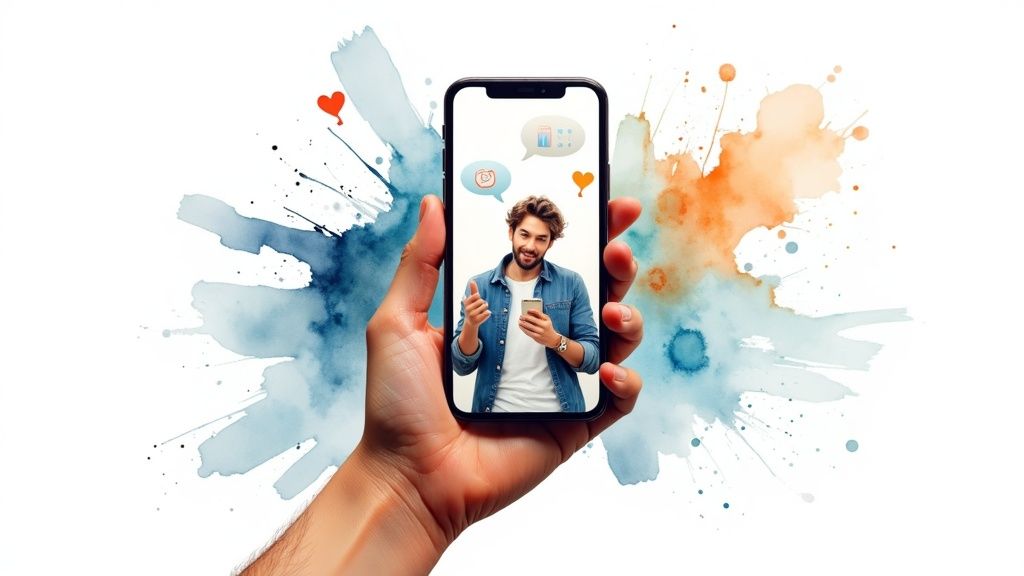Curious why is livestream shopping popular? Learn how consumer psychology, technology, and brands are fueling this e-commerce trend. Click to find out!
In This Article
Subscribe to our newsletter
So, what’s the big deal with livestream shopping? At its core, it's a powerful mix of live entertainment and instant commerce. Think of it as the old-school home shopping network, but completely revamped for the social media age—making the whole experience feel less like a transaction and more like a fun, interactive event.
The Secret Behind Livestreaming’s Explosive Growth
The real magic of livestream shopping isn't just about clicking "buy now." It's about crafting an experience. The format brilliantly merges the raw, unscripted energy of a live broadcast with the immediate satisfaction of e-commerce. It breaks down that digital wall between a brand and its audience, pulling everyone into a shared, real-time moment.

This completely changes the game from passive scrolling to active participation. Shoppers aren't just staring at static product pages anymore. They're jumping into a dynamic conversation where they can ask questions, see products demonstrated on the spot, and get instant feedback from both the host and other viewers buzzing in the chat.
The Core Appeal: What Makes It So Compelling?
To really get why live commerce is blowing up, you have to look at the psychological and tech drivers that make it so addictive. Its meteoric rise fits perfectly within the latest social media trends that are changing how we all connect and buy things online. This new way of shopping forges genuine connections between brands, creators, and customers through a few key ingredients.
At its heart, live shopping makes buying feel less like a transaction and more like a community event. It taps into our fundamental desire for connection, entertainment, and validation.
The table below breaks down the key reasons people are flocking to these live events. Each driver plays a crucial role in creating a shopping experience that feels personal, urgent, and trustworthy.
Core Reasons Livestream Shopping Is So Appealing
| Key Driver | What It Is | Why It Works |
|---|---|---|
| Authenticity & Trust | Hosts, often relatable influencers, build a genuine rapport with the audience. | Recommendations feel like advice from a trusted friend, not a cold corporate sales pitch. |
| Urgency & Scarcity | Limited-time offers and exclusive products are available only during the stream. | This creates a powerful sense of FOMO (fear of missing out), pushing viewers to buy immediately. |
| Community & Engagement | The live chat allows viewers to interact, share opinions, and see what others are buying. | This provides strong social proof, validating a shopper's own decision to make a purchase. |
These elements work together to create a powerful flywheel effect. As we go through this guide, we'll dive deeper into each of these drivers, showing you exactly what makes this retail format a global phenomenon.
So, what’s all the fuss about? How does modern livestream shopping actually work?
To really get it, you have to stop thinking about traditional e-commerce. Picture a mashup of your favorite creator’s Instagram Live feed and a fully interactive online shop. It’s one seamless experience where entertainment and commerce aren't just next to each other—they're completely fused.
At the center of it all is the host. This could be someone from the brand, a subject matter expert, or a trusted influencer. They’re not just reading a script; they’re showing off products in real time, creating a dynamic, personal presentation that feels completely off-the-cuff.
This live format is the secret sauce. Viewers are no longer just passively scrolling through static product pages. They’ve become active participants in a live event.
The Seamless User Journey
The real magic happens in the loop between the host and the audience. This two-way street transforms shopping from a solo mission into a shared, communal experience.
Here’s a typical play-by-play:
- Real-Time Interaction: Viewers can pop questions into a live chat. Think things like, "Does that fabric wrinkle easily?" or "Can you show what fits inside that bag?"
- Instant Demonstrations: The host sees these questions and responds on the spot. They might crumple the fabric and hold it up to the camera or start stuffing the bag with their phone, keys, and wallet to show off its capacity.
- Social Proof in Action: As people in the chat get excited and you see purchase notifications pop up, it creates a powerful wave of validation and trust.
This instant feedback eliminates all the usual guesswork and doubt of online shopping. The best live product demos feel less like a sales pitch and more like getting advice from a knowledgeable friend. Nailing this presentation is a huge part of the puzzle, and we cover exactly how to create product demo videos that actually convert in our detailed guide.
From Entertainment to Purchase in One Click
Now for the final, and most critical, piece: the frictionless path to purchase. This is where livestream shopping leaves old-school formats like TV shopping networks in the dust.
The core innovation is that viewers never have to leave the live event to buy. Products are displayed as clickable overlays or in a shoppable sidebar right next to the video stream.
When a viewer is sold on an item, they don't have to open a new tab, hunt for the product on a website, or remember a promo code. A single click on the product right there in the stream adds it to their cart. A few more clicks, and the purchase is complete.
This "shoppertainment" model completely collapses the sales funnel, turning that spark of excitement directly into a sale. The purchase feels like a natural extension of the entertainment itself.
The Psychology Driving Millions to Watch and Buy
To really get why livestream shopping has blown up, you have to look past the tech and dive into a bit of human psychology. This format doesn't just make it easier to buy things; it taps into some deep-seated triggers that shape our decisions. It's a powerful cocktail of urgency, social validation, and personal connection that makes the whole experience feel irresistible.
This isn't like passively scrolling through an online catalog. It’s a live event, and that "live" element is the secret sauce. The entire experience is built to make you feel like you're part of something special, fleeting, and genuinely exciting.
The Power of Urgency and Scarcity
One of the most potent psychological triggers in live commerce is the Fear of Missing Out, or FOMO. Hosts are absolute masters at creating this feeling, weaving in elements of scarcity and urgency that are almost impossible to ignore.
Think about it: a "livestream-only" discount code that vanishes the second the broadcast ends. A limited-stock item you can see selling out in real-time. These aren't just sales tactics; they are powerful psychological nudges.
This manufactured urgency compresses the decision-making process from days into mere minutes. A recent report found that 42% of US shoppers think live events are fun, partly because the time-sensitive nature turns shopping from a chore into a thrilling game where quick thinking pays off.
The core idea is simple but incredibly effective: "If you don't buy it now, you'll miss out forever." This taps directly into our natural aversion to loss, pushing viewers to act immediately rather than risk feeling regret later.
This feeling of immediacy is cranked up to eleven by the interactive environment, where the energy of the crowd fuels individual buying decisions.
The Influence of Social Proof
We’re social creatures. We instinctively look to others for cues on how to act, and livestream shopping leverages this tendency beautifully through social proof. When you jump into a stream and see thousands of other people watching, commenting, and getting "purchase successful" notifications, it sends a powerful signal: this product is legit and people want it.
The live chat is a buzzing hive of social validation. Potential buyers see real-time questions getting answered and authentic praise from other shoppers. This is infinitely more persuasive than curated, static reviews on a product page because it’s happening right now, with real people. This dynamic interaction is a key part of what makes for great e-commerce video, a topic we explore in our guide to ecommerce video marketing secrets that drive real sales.
This infographic shows just how engaging and effective this model really is, breaking down the key metrics that highlight its power.

The data speaks for itself. Viewers aren't just watching passively; they're highly engaged and converting at rates that are fueling massive revenue growth.
Building Trust Through Personal Connection
Beyond urgency and crowd psychology, live shopping is built on relationships. Hosts, especially influencers, are pros at cultivating what are known as parasocial relationships—that one-sided bond where viewers feel like they actually know the host. A great host doesn't come across like a salesperson; they feel like a trusted, super-knowledgeable friend.
They share personal stories, respond to comments by name, and offer advice that feels genuine and personal. When this "friend" recommends a product, it doesn't land like a cold sales pitch. It feels like an authentic suggestion from someone you trust, built on the rapport they've established throughout the stream.
This completely changes the dynamic of the sale. You're not just buying a product; you're buying into the host's taste, expertise, and personal recommendation. This blend of entertainment, community, and commerce—often called "shoppertainment"—is the final piece of the puzzle, turning a simple transaction into a fun and memorable social event.
Understanding the Data Behind the Global Boom
To really get why livestream shopping is taking over, we need to look past the hype and dive into the hard numbers. The data tells an undeniable story of a retail revolution, not just some fleeting trend. This isn't a small adjustment; it's a fundamental change in how people shop, and it’s happening on a massive scale.

It’s hard to wrap your head around the sheer size of this boom without seeing the data. While the idea is catching on everywhere, its explosive growth started in one place that essentially created the playbook for the rest of the world.
The Chinese Blueprint for Success
The incredible popularity of live shopping owes a lot to its colossal success in China, which completely dominates the space with over 78% of the global market. By 2023, sales from live shopping in China soared to an astonishing $4.9 trillion in gross merchandise volume (GMV).
So, what’s their secret? It’s a combination of a few key things: deeply integrated e-commerce giants like Taobao, where millions of people tune in daily, and sky-high consumer trust in the influencer hosts.
This success in the East has given Western markets a clear path to follow. While the numbers aren't quite as massive (yet), the core ingredients—interaction, trust, and entertainment—are proving to be just as powerful.
Livestream shopping is no longer an experiment. It's a proven, multi-trillion-dollar global industry. The question for brands isn't if they should adopt it, but how they can catch up.
The ripple effect is now impossible to ignore, with markets across the globe experiencing their own growth spurts as they adapt the model to fit their audiences.
Western Markets Are Catching Fire
While China created the blueprint, the West is quickly catching on. Europe has seen an 86% jump in livestream shoppers, and North America is right there with a 68% increase since 2020. This rapid growth is being supercharged by better digital infrastructure and the rise of social commerce on the very platforms where consumers already spend their time.
The numbers don't lie. This is a global phenomenon with a consistent pattern of growth. The formula of mixing entertainment with the ability to buy instantly clicks with consumers everywhere.
This growth trajectory presents both a huge opportunity and a measurement challenge for brands. For those trying to quantify the impact of live events, learning how to measure social media success provides invaluable frameworks for tracking engagement, conversion, and ROI.
Global Live Commerce Market Forecast
This table illustrates the powerful growth trajectory of live commerce across key global regions, showing its sustained momentum.
| Region | Current Market Value | Projected Market Value | Projected CAGR |
|---|---|---|---|
| Global | $689 Billion | $6.2 Trillion | 31.6% |
| China | $540 Billion | $4.9 Trillion | 31.7% |
| North America | $68 Billion | $621 Billion | 31.8% |
| Europe | $42 Billion | $319 Billion | 28.8% |
The data paints a clear picture. From the established market in China to the rapidly expanding scenes in North America and Europe, live commerce is on a solid upward path.
It’s a clear signal that the way consumers discover and buy products has permanently changed, with interactivity now sitting at the very heart of the experience.
Why Smart Brands Are Going All-In on Live Commerce
The explosive growth of livestream shopping isn't just some passing consumer trend; it's a strategic goldmine for businesses. Brands aren't just dipping their toes in the water anymore—they're diving headfirst into live commerce because the benefits are real, immediate, and incredibly powerful.
This is about much more than just opening up another sales channel. It’s about forging deeper connections with customers and sparking some serious growth.
One of the biggest draws for brands is the dramatic boost in conversion rates. Think about the typical online shopping journey: a customer visits a product page, skims some reviews, and maybe mulls over the purchase for a few days. Live shopping takes that entire process and crushes it down from days into mere minutes.
So, how does this happen? It’s a mix of two things. First, the live format creates a natural sense of urgency with its limited-time deals and exclusive product drops. Second, it lets brands tackle customer questions in real time, wiping away any hesitation and building trust right when someone is ready to buy.
A Direct Line to Customer Insights
Beyond the immediate sales rush, live commerce serves up something just as valuable: a stream of raw, unfiltered customer feedback. In a traditional retail model, getting this kind of intel is a slow, expensive process, usually involving surveys or focus groups that happen long after the fact.
But during a livestream, that comment section is pure gold. Brands can see, right then and there:
- Which features are actually getting people excited.
- What questions or concerns keep popping up.
- The exact words customers use to talk about their problems and needs.
This direct line to the customer is priceless. It gives marketing, product, and sales teams the power to make smarter, data-backed decisions based on what people are saying right now, not what they said last quarter. It’s an approach that works wonders for any video-first strategy, including figuring out how best to use video ads for publishers to drive both engagement and revenue.
By simply keeping an eye on the live chat, brands get an honest, no-cost focus group. This allows them to pivot their messaging on the fly and gather insights that will shape future products and marketing campaigns.
Building Authentic Communities and Lasting Loyalty
Maybe the most powerful long-term benefit is the chance to build a real community around your brand. Livestreaming cuts through the polished, corporate feel of traditional ads and brings back a bit of human connection. When a host actually calls out viewers by name and shares a personal story, it makes people feel like they’re part of something.
This isn't about a single transaction; it's about building a loyal base of fans who feel seen and heard. One recent study found that over half of livestream viewers tune into shoppable streams multiple times a week. That just goes to show how effective this format is at creating repeat, engaged customers who become a huge asset for future launches.
Of course, to make the most of this, brands have to nail their strategies to increase live event viewership and make sure these community-building moments reach as many people as possible.
At the end of the day, smart brands get it: in this market, authenticity is what sells. And live commerce is arguably the most authentic sales channel out there, building the kind of trust and loyalty that lasts long after the broadcast ends.
The Tech Stack Supercharging Modern Retail
The raw, interactive appeal of livestream shopping is really just the tip of the iceberg. Under the surface, there's a sophisticated tech stack working seamlessly to make the magic happen. This isn't just about a good camera and a charismatic host; it's about the technology that makes the entire experience feel more immersive, intelligent, and incredibly convenient. These tools are what turn a simple broadcast into a powerhouse retail engine.

This potent blend of new tech and shifting consumer habits is precisely why the global livestream e-commerce market is projected to explode. We're talking a leap from around $19.86 billion in 2025 to a staggering $258.76 billion by 2034. This growth is fueled by tools that make shopping streams more personal and interactive than ever before. Big brands like Zara are already on board, launching tailored live shopping events for key markets to stay ahead of the curve. You can dig deeper into this monumental shift in the livestream e-commerce market forecast.
AI: The Personal Shopper in the Machine
Artificial intelligence (AI) is the invisible brain powering the best livestream experiences. It works quietly in the background, analyzing viewer behavior, comments, and past purchases to serve up hyper-relevant product recommendations on the fly. This is what turns a one-to-many broadcast into a collection of deeply personal one-to-one moments.
Imagine you're watching a fashion stream and type a comment about loving a particular color. The platform's AI can instantly start showing you other items in that same shade or accessories that would pair perfectly with it. This is so much more than a simple sales bot; it's a dynamic personal shopper that understands your preferences in real time, making you feel seen and catered to.
AI's true power in live commerce is its ability to anticipate a shopper's needs before they even type them. It transforms the experience from "what's for sale" to "what's right for me."
This level of personalization doesn't just boost conversion rates. It makes the whole shopping experience feel unique and special, which is key to building genuine viewer engagement and long-term loyalty.
AR and VR: Bridging the Digital-Physical Gap
One of the biggest hurdles in online shopping has always been the inability to really see or feel a product. Augmented Reality (AR) and Virtual Reality (VR) are systematically dismantling that barrier, making them cornerstones of modern live commerce.
AR technology enables "virtual try-ons," a total game-changer for industries like fashion and beauty. With just a few taps, a viewer can see how a pair of sunglasses looks on their face or how a shade of lipstick appears on their skin tone, all through their smartphone. It’s almost like having the store in your living room.
This interactive element solves a few key problems:
- It reduces purchase anxiety. Seeing the product "on" you removes a ton of guesswork and builds confidence in the buying decision.
- It lowers return rates. When customers have a better sense of what they're getting, they are far less likely to send it back.
- It creates a "wow" factor. Let's be honest, the novelty and utility of AR make the shopping experience more memorable and fun.
And while VR is still finding its footing, it promises even more immersive experiences, like letting you step into a virtual showroom to browse products right alongside the host. The possibilities are huge.
5G: The Engine for a Flawless Experience
Finally, none of this high-tech wizardry would be possible without a rock-solid foundation. Ultra-fast 5G networks provide the high-speed, low-latency connection needed for a flawless, buffer-free streaming experience. A laggy, pixelated video is an instant turn-off for viewers and can kill the momentum of a live event.
5G ensures that the high-definition broadcast stays smooth and uninterrupted, even with thousands of viewers all interacting at the same time. This reliability is absolutely essential for maintaining viewer immersion and trust. When the tech works perfectly, it becomes invisible, allowing the host and the products to be the real stars of the show.
Common Questions About Livestream Shopping
Even with its incredible rise, livestream shopping is still a new frontier for many. If you've still got some questions buzzing around your head, you're not alone. Let's tackle some of the most common ones to clear up any lingering confusion about how it all works.
Think of this as the final piece of the puzzle, explaining why this isn't just another sales channel, but a genuine form of entertainment that’s reshaping retail.
What Kinds of Products Sell Best?
Honestly, you can sell just about anything live, but some products are just a natural fit for this kind of interactive, show-and-tell format. The things that really fly off the virtual shelves are the ones that benefit from a live demonstration—where seeing it in action is so much more powerful than just reading about it.
It really clicks for categories like these:
- Fashion and Apparel: Viewers get to see how a dress actually moves or how a jacket fits on a real person. Questions about fabric, fit, and sizing get answered on the spot, visually.
- Beauty and Cosmetics: Live makeup tutorials are a slam dunk. A host can show exactly how to apply a product, swatch colors on their skin, and explain why one serum is better for a certain skin type than another.
- Consumer Electronics: Unboxings, feature demos, and setup guides are gold. A host can walk through a new gadget's features, answer technical questions in real-time, and build a ton of confidence for potential buyers.
- Food and Kitchenware: Nothing makes you want a new air fryer more than watching someone cook perfectly crispy fries in it live. Seeing the delicious results firsthand makes the product irresistible.
The common thread here? These products all have a story to tell, and a live host brings that story to life in a way a static product page never could.
Is This Trend Only for Big Brands?
Not a chance. While you’ll see giants like Zara and Walmart making waves, one of the most exciting things about livestream shopping is how it levels the playing field for small and medium-sized businesses. It’s a true equalizer.
Livestreaming gives smaller brands a direct, authentic line to their audience. It lets them build a loyal community and drive real sales without needing a massive marketing budget.
Platforms like TikTok Shop, Instagram Live, and YouTube have built-in tools that let anyone with a phone go live and start selling. A small boutique can create a personal, engaging shopping night that feels more special and connected than anything a massive retailer could ever replicate. It’s about the connection, not just the scale.
How Is It Different From Influencer Marketing?
That's a great question, because they definitely overlap. The simplest way to think about it is that livestream shopping is a super-charged, highly specific type of influencer marketing.
In a traditional influencer campaign, a creator might post a cool photo or a pre-recorded review. Their job is to build awareness and hopefully send their followers over to a brand’s website.
Livestream shopping, on the other hand, is a live, interactive sales event. The game-changing difference is the instantaneous path to purchase. Viewers don't have to click away, open a new tab, and hunt for the product. They can buy it right there, right then, without ever leaving the stream. It collapses the entire sales funnel, turning the excitement an influencer generates directly into a sale.
This powerful formula is why the global live commerce market is exploding. It's currently valued at around $1 trillion and is on track to hit $3.7 trillion by 2030. In the U.S. alone, the market is expected to grow at a blistering 47% annual rate. This isn’t just a fad; it’s a fundamental shift in how people shop, driven by the demand for mobile convenience and real-time engagement. To see the full scope of this growth, check out these live commerce statistics and projections.
At Aeon, we understand the power of video to connect with audiences and drive results. Our platform helps publishers automatically transform their existing content into engaging, high-quality videos perfect for capturing attention in any format. Discover how Aeon can scale your video production and supercharge your content strategy.


.jpg)